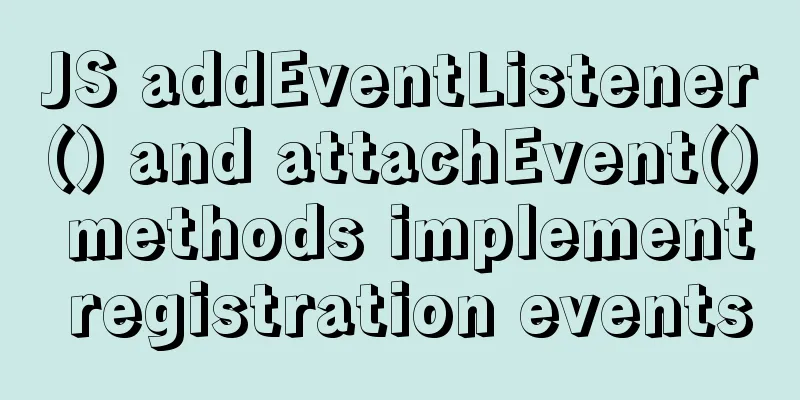In-depth explanation of the various methods and advantages and disadvantages of JavaScript inheritance

1. Prototype chain inheritance
function Parent () {
this.name = 'kevin';
}
Parent.prototype.getName = function () {
console.log(this.name);
}
function Child () {
}
Child.prototype = new Parent();
var child1 = new Child();
console.log(child1.getName()) // kevin
question: 1. The properties of reference types are shared by all instances. For example:
function Parent () {
this.names = ['kevin', 'daisy'];
}
function Child () {
}
Child.prototype = new Parent();
var child1 = new Child();
child1.names.push('yayu');
console.log(child1.names); // ["kevin", "daisy", "yayu"]
var child2 = new Child();
console.log(child2.names); // ["kevin", "daisy", "yayu"]
2. When creating an instance of Child, you cannot pass parameters to Parent 2. Borrowing constructors (classical inheritance)
function Parent () {
this.names = ['kevin', 'daisy'];
}
function Child () {
Parent.call(this);
}
var child1 = new Child();
child1.names.push('yayu');
console.log(child1.names); // ["kevin", "daisy", "yayu"]
var child2 = new Child();
console.log(child2.names); // ["kevin", "daisy"]
advantage:
For example:
function Parent (name) {
this.name = name;
}
function Child (name) {
Parent.call(this, name);
}
var child1 = new Child('kevin');
console.log(child1.name); // kevin
var child2 = new Child('daisy');
console.log(child2.name); // daisy
shortcoming:
3. Combination inheritancePrototype inheritance and classical inheritance work together.
function Parent (name) {
this.name = name;
this.colors = ['red', 'blue', 'green'];
}
Parent.prototype.getName = function () {
console.log(this.name)
}
function Child (name, age) {
Parent.call(this, name);
this.age = age;
}
Child.prototype = new Parent();
var child1 = new Child('kevin', '18');
child1.colors.push('black');
console.log(child1.name); // kevin
console.log(child1.age); // 18
console.log(child1.colors); // ["red", "blue", "green", "black"]
var child2 = new Child('daisy', '20');
console.log(child2.name); // daisy
console.log(child2.age); // 20
console.log(child2.colors); // ["red", "blue", "green"]
Advantages: It combines the advantages of prototype chain inheritance and constructor function and is the most commonly used inheritance mode in JavaScript. 4. Prototype inheritance
function createObj(o) {
function F(){}
F.prototype = o;
return new F();
}
It is a simulated implementation of Disadvantages: Property values containing reference types always share the corresponding values, just like prototype chain inheritance.
var person = {
name: 'kevin',
friends: ['daisy', 'kelly']
}
var person1 = createObj(person);
var person2 = createObj(person);
person1.name = 'person1';
console.log(person2.name); // kevin
person1.firends.push('taylor');
console.log(person2.friends); // ["daisy", "kelly", "taylor"]
5. Parasitic inheritanceCreate a function that is used only to encapsulate the inheritance process, which internally enhances the object in some form and finally returns the object.
function createObj (o) {
var clone = object.create(o);
clone.sayName = function () {
console.log('hi');
}
return clone;
}
Disadvantages: Like the borrowed constructor pattern, a method is created each time an object is created. 6. Parasitic Combinatorial InheritanceFor your convenience, let's repeat the combined inheritance code here:
function Parent (name) {
this.name = name;
this.colors = ['red', 'blue', 'green'];
}
Parent.prototype.getName = function () {
console.log(this.name)
}
function Child (name, age) {
Parent.call(this, name);
this.age = age;
}
Child.prototype = new Parent();
var child1 = new Child('kevin', '18');
console.log(child1)
The biggest disadvantage of composite inheritance is that the parent constructor is called twice. Once is when setting the prototype of a subtype instance: Child.prototype = new Parent(); Once when creating an instance of the subtype:
var child1 = new Child('kevin', '18');
Recall the simulation implementation of new. In fact, in this sentence, we will execute: Parent.call(this, name); Here, we call the Parent constructor again. So, in this example, if we print the So how can we strive for excellence and avoid repeated calls this time? What if we don’t use See how it is implemented:
function Parent (name) {
this.name = name;
this.colors = ['red', 'blue', 'green'];
}
Parent.prototype.getName = function () {
console.log(this.name)
}
function Child (name, age) {
Parent.call(this, name);
this.age = age;
}
// Three key steps var F = function () {};
F.prototype = Parent.prototype;
Child.prototype = new F();
var child1 = new Child('kevin', '18');
console.log(child1);
Finally, we encapsulate this inheritance method:
function object(o) {
function F() {}
F.prototype = o;
return new F();
}
function prototype(child, parent) {
var prototype = object(parent.prototype);
prototype.constructor = child;
child.prototype = prototype;
}
// When we use:
prototype(Child, Parent);
Quoting the praise of parasitic combinatorial inheritance in "Advanced JavaScript Programming": The efficiency of this approach is that it only calls the This concludes this article on in-depth explanation of the various ways of inheritance in JavaScript and their advantages and disadvantages. For more information on various ways of inheritance in JavaScript and their advantages and disadvantages, please search for previous articles on 123WORDPRESS.COM or continue to browse the related articles below. I hope you will support 123WORDPRESS.COM in the future! You may also be interested in:
|
>>: Detailed explanation of character sets and validation rules in MySQL
Recommend
3 ways to add links to HTML select tags
The first one : Copy code The code is as follows: ...
Vue3+TypeScript encapsulates axios and implements request calls
No way, no way, it turns out that there are peopl...
Solution for VMware Workstation Pro not running on Windows
After the National Day holiday, did any of you fi...
How to Find the Execution Time of a Command or Process in Linux
On Unix-like systems, you may know when a command...
Detailed explanation of the process of creating floor navigation effects with JavaScript
Table of contents Objectives for this period 1. F...
How to deploy multiple Vue projects under the same domain name using nginx and use reverse proxy
Effect There are currently 2 projects (project1, ...
React implements import and export of Excel files
Table of contents Presentation Layer Business Lay...
Ubuntu16.04 builds php5.6 web server environment
Ubuntu 16.04 installs the PHP7.0 environment by d...
The difference between name and value in input tag
type is the control used for input and output in t...
Quickly solve the problem of slow startup after Tomcat reconfiguration
During the configuration of Jenkins+Tomcat server...
How to use docker to build redis master-slave
1. Build a Docker environment 1. Create a Dockerf...
Detailed explanation of 30 SQL query optimization techniques for MySQL tens of millions of large data
1. To optimize the query, try to avoid full table...
How to configure VMware multi-node environment
This tutorial uses CentOS 7 64-bit. Allocate 2GB ...
Detailed explanation of the specific use of the ENV instruction in Dockerfile
1. The ENV instruction in the Dockerfile is used ...
Detailed steps for configuring Tomcat server in IDEA 2020
The steps for configuring Tomcat in IDEA 2020 are...









